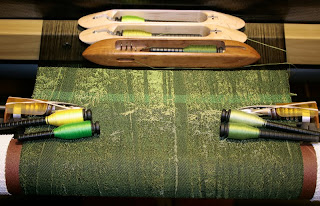One side effect of my decision to mount weavings on canvas stretchers is a decreased ease of shipping. With a wall piece mounted by a hanging rod, whether there's a reinforcing rod in the bottom or not, all I needed to do was roll the wall piece around a firm core tube (something like the center of a paper towel roll, but longer), and then wrap it up in tissue and foam sheets and stuff it into a nice sturdy cardboard mailing tube.
I've used this method to ship work all over the US - and several to the UK - and as far as I know, they've all arrived safely and intact.
However, a wall piece mounted on a canvas stretcher requires a box. Naturally, there's never a commercial box with the appropriate dimensions. Today, I had to run around to 3 stores looking at shipping boxes, and although what I wanted was 14 by 14 by 3 or 4 inches, what I got was 14 by 14 by 14. Out came the box knife and metal straight edge, and the box soon shrank to 14 by 14 by 4 inches. Then, of course, there's the issue of packing materials. Luckily this household is inhabited by packrats, and we stash away any bubble wrap or air pillows that we receive from Amazon (or wherever).
All this to say that the piece for the exhibit in New Mexico finally got to UPS about 5 minutes before closing time today, and will reach its destination before the deadline. Hey, the UPS driver was idling his motor in the parking lot while I dealt with the nice woman at The UPS Store - what timing! The box went straight onto the truck!

You might have seen this (or part of it) on the loom. I actually like it better cropped to the required 12 by 12 inches - what it lost was wasted real-estate, anyway.
In any case, if there are any blog readers in the Albuquerque area, please visit the BECA Lab A.D. (art & design) exhibit at New Studio A.D. at 312 Rosemont Ave NE between February 4 and February 18, 2011. If you go, and if you have a camera with you, and if photos are allowed, please take a shot or two for me of the piece
in situ?
One of my few New Year's Resolutions is to be very diligent about submitting work to as many textile-related exhibits as possible. I've been lax about the submission thing this past year, but now? I'm on it! Some deadlines coming up are January 17 (Textiles in a Tube), February 4 (Olive Hyde Gallery 43rd Annual Textiles Exhibit), and March 7 (HGA's Small Expressions).
Textiles in a Tube, for obvious reasons, means easy shipping, and I have a piece already chosen to submit. The Olive Hyde Gallery is in Fremont, California, close enough to hand-deliver; but Small Expressions requires work to be a maximum of 15 inches in any dimension, so that means the piece must be mounted on a canvas stretcher (or otherwise cropped somehow from the loom-standard 16.5-inch finished width).
Back to work! Don't we all love paperwork? And that's all the submission thing is, just more paperwork. Oh, goody. I'd rather be weaving, but this year, I've vowed to conquer the paperwork.






























